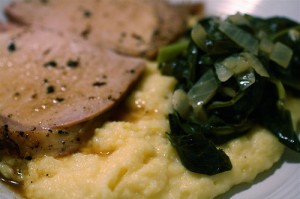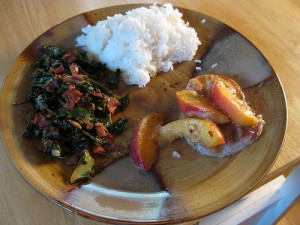
Southern-style low oxalate greens with pork roast and cheesy mashed cauliflower (a great, grain-free alternative to mac-n-cheese).
Southerners are well known for their greens, and for good reason! I love my low oxalate greens cooked southern-style with just a touch of Tabasco Sauce or cayenne pepper. Southern cooking most commonly features turnip or collard greens — two greens you can eat in moderation on a low oxalate diet. I also like to mix in one of the lowest oxalate greens — mustard greens — to add a little spice, and to lower the oxalate content. This recipe features low oxalate cooking techniques, but otherwise this is a traditional version of southern-style greens. And yes, it’s okay. . . go ahead and drink a little of that heavenly pot liquor at the end (the cooking liquid). It should contain minimal soluble oxalate since you already poured off most of the soluble oxalate in the second cooking step. If you’re a vegetarian make sure to check out the vegetarian version, too. Southern-style greens are known for the use of a ham hock for flavor, but many southern cooks make their greens without it.
Try southern-style low oxalate greens with pork roast, baked fish or roasted chicken, black-eyed peas and low oxalate, gluten-free mac-n-cheese for a low oxalate soul food dinner that will leave you smiling. Hope you enjoy!
Southern-Style Low Oxalate Greens
1 large preferably uncured ham hock (about a pound)
1 1/2 pounds collard, turnip or mustard greens (about 4 or 5 big bunches)
1 yellow onion, chopped
2- 4 cloves garlic
1/2 teaspoon Celtic sea salt
1 – 2 teaspoons Tabasco Sauce (or a pinch or two cayenne pepper)
Step 1: Put your ham hock in a pot with about a quart of water and bring it to a boil. Reduce the heat, cover and let it cook for about an hour. Make sure the water doesn’t cook out — you want it to be sitting in at least a cup or two of liquid at all times. You’ll know the ham hock is done when the meat starts to fall off the bone.

Southern-style low oxalate greens made with bacon and served with peach-covered pork chops and rice.
Step 2: While the ham hock is cooking, prepare your greens by washing and rinsing them numerous times. If the leaves are young and the stems are small and bend easily, you do not have to remove them. If the stem or the rib (the part of the stem that’s surrounded by leaf) seem big and inflexible, remove them with a knife or by tearing the stem and rib away from the leaf. Mustard greens have a tendency toward big stems and almost always have to be de-ribbed. If the leaves are big, too, you will also need to cut them into smaller pieces (I do this by piling a bunch of leaves on top of each other, then rolling them into a cylinder and cutting them to make circular “coins” that unroll into strips). Bring about 2 quarts of water to boil in a large soup pot. Add the greens to the pot and let boil for about 10-12 minutes (if you’ve got too many greens to fit into the pot, just wait a minute for the ones in the pot to boil down a bit before adding more greens). When the greens are finished boiling, strain them in a stainless steel colander and rinse to remove any excess cooking water (this cooking water contains a lot of soluble oxalate and should be avoided by most people on a low oxalate diet).
Step 3: Add the strained greens, onion, garlic, salt and Tabasco sauce to the pot with the ham hock. Bring the mixture to a boil then turn the heat to low and let simmer, covered, for 1 to 2 hours. You will occasionally want to stir the pot and maybe help some of the meat to fall away from the bone if you want to eat the meat with the greens (some cooks throw out the meat when the greens are done, only using the meat for seasoning, but I definitely eat it). Make sure the liquid doesn’t cook out; add a little water if it seems like less than a cup or two of liquid is left. Alternately, if you have a very tight lid and none of the liquid seems to have cooked out, you may want to leave the lid off the pot for a little while to keep your greens from being too soupy.
Makes about 5-6 cups of southern -style low oxalate greens.
Variations: You may use about a half pound bacon instead of the ham hock. Cook the bacon in the dutch oven until it’s crisp, then cut it into small pieces. Add the onions and garlic to the bacon fat and cook until the onions are translucent. Continue with steps 2 and 3 as written.
You may also make a vegetarian version of this dish by skipping step 1 and adding a couple tablespoons of butter or olive oil to the pot in step 3. You will probably also want to add a little more salt. Serve these greens with seasoned black-eyed peas and low oxalate mac-n-cheese for a comforting soul food vegetarian meal.
Low Oxalate Info: The oxalate content of Southern-Style Low Oxalate Greens will vary greatly depending on which greens or mix of greens you use. Boiled mustard greens and turnip greens are both low oxalate with less than 5 mg. oxalate per half cup. Boiled collard greens have not been tested, but steamed collard greens are medium oxalate (10.4 mg. oxalate per half cup — tested by the VP Foundation, 2004). If boiling reduces the soluble oxalate content of turnip greens, mustard greens, brussel sprouts and kale — often by more than a half, then boiling probably reduces the soluble oxalate content of collard greens as well — we just don’t know by how much! I use what I consider a safe estimate of about 8 mg. oxalate per half cup boiled collard greens, but you may want to be more conservative in your estimate. My favorite mix of low oxalate greens is two thirds mild turnip greens and one third spicy mustard greens, or one third each of the three greens. All other ingredients in southern-style low oxalate greens are low oxalate (onion) or very low oxalate (ham hock, garlic, Tabasco sauce and salt).
UPDATE 6/5/12: Since writing this I found the value of boiled collard greens in another part of my low oxalate food list (oy!). That’s the problem with a 196 pg. list. Things get lost or overlooked pretty easily. Anyway, boiled collard greens have 8.7 mg. oxalate per half cup according to the Low Oxalate Cookbook 2, so my estimate of 8.0 mg. was pretty close. Enjoy those collard greens!
Picky Eater Pleaser: I find that my boys are more willing to try my greens if they’ve helped me to pick them from the garden or to pick them out at the farmers’ market. The are also more likely to try a bite if it has a nice, juicy piece of pork, no onion and minimal greens. That said, they usually won’t eat more than a bite or two of my greens, although I do keep trying.
Other Diets: Southern-style low oxalate greens may also be suitable for low carb, Paleo, gluten-free, dairy-free, GFCF and GAPS diets. If you follow the GAPS diet be sure to use a raw or uncured ham hock.
Photo credits go to thebittenword.com for pork rib roast with collard greens , karindalziel for dinner and andrechinn for Owen picks collard greens.

{ 1 comment… read it below or add one }